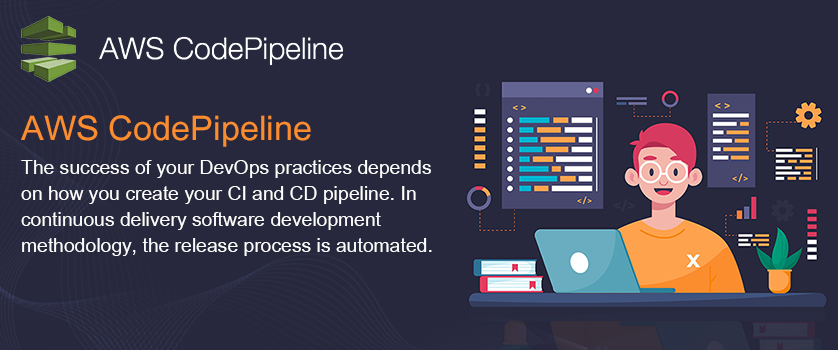


The success of your DevOps practices depends on how you create your CI and CD pipeline. In continuous delivery software development methodology, the release process is automated. Every time a change in the code happens, it is automatically built, tested, and deployed to production.
Whereas, in continuous integration software development practice, team members use a version control system and frequently integrate their work to the same location, such as the main branch. Each change is built and verified to detect integration errors as quickly as possible. Continuous integration is focused on automatically building and testing code, as compared to continuous delivery, which automates the entire software release process up to production.
AWS CodePipeline is a continuous delivery service that helps you release your software. With AWS CodePipeline, you can make the full release process for building your code, deploying to pre-production environments, testing your application, and releasing it to production. Further, it builds, tests, and deploys your application according to the defined workflow every time code changes. Apart from that, you can integrate various tools (partner or custom) into any stage of the release process to form an end-to-end continuous delivery solution.
Lululemon is a Canadian company that sells yoga-inspired apparel and other clothing at more than 350 locations throughout the world. Several years ago, Lululemon planned to offer digital services and push out new applications and features faster. However, the company had a crowded IT department and it wasn’t easy to develop new applications quickly.
For example, the company’s developers needed to set up development environments, which used to take many days even for small-scale experiments. Besides being costly, the process wasn’t fast enough. Lululemen experienced the need for streamlining its development processes to support its new continuous integration and delivery focus. The organization’s agenda was clear: simplify management and automate as many development processes as possible.
As a result, Lululemon chose AWS services to engineer a fully automated, continuous integration and delivery system. Although the company used various AWS services, yet of all the services, the most preferred were only two:
Once the changes were made, the company witnessed many benefits like:
From an organization’s perspective, the deployment time is crucial because it could make or break the situation. If things work as planned, then there is no trouble, but by any means, you receive negative feedback from the users, all your hard work goes in vain. The development itself is a critical task, and on top of it, if you have to fix the issues post-deployment, it doubles your cost and pain. And everyone hates it, that’s why they invest in a continuous delivery tool like AWS CodePipeline.
It builds, tests, and deploys your applications faster and lets you integrate various tools with it.